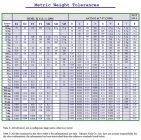5 year old original post.I use ASTM Class 1 and 2 weights.
Getting ready to do some sorting (3.700 grains).
Check weights 200mg, 30mg, and 10mg.
Using gram mode, low range on my EJ-54D2 gives me 0.0002g resolution (0.00309grains).
0.2398g +/- a count should do it.
I'll use my A&D ER-182A to spot check results.
View attachment 1539407
You are using an out of date browser. It may not display this or other websites correctly.
You should upgrade or use an alternative browser.
You should upgrade or use an alternative browser.
Which Scale Check Weights?
- Thread starter AROKHUNTER
- Start date
YUP, but I didn't wake it up 
Dave M.
F-Open Class shooter (284 win, 6dasher, 6.5-7PRCW)
You clearly don’t understand what Dusty and many other people are doing as well. No true need for a calibrated weight because you really don’t care if you are putting 31.2 or 31.4gr of powder in the case, just that you are putting the exact amount that the rifle was tuned to. Dusty most likely has a bullet or a dummy round that has a mass of 208.50grains and before he starts dispensing charges, he will zero the scale out and then weigh the dummy round. Certain reasons may cause the dummy round to weigh .14gr high, then he will know that to get the same charge in his rounds that normally use 30.0gr, he should be dispensing 30.14gr. I’m not sure I can explain it any better than that for you. Dusty, correct me if I have stated anything incorrectly.This has got to be one of DUMBEST POSTS i have seen,bullets vary in weight,JOIN the NIT CLUB
Dave
Last edited:
Things found around the kitchen or reloading room that can be accurately measured, expected to remain stable over the years are fine.
Relative measurements, for sorting, don't really require high accuracy, just long term stability. They possess 'SAMENESS'. Same today as yesterday.
Don't lose your sameness standard.
For those with scales that CALIBRATE @ 50, or 100 GRAMS, linearity and drift at smaller values are the problem. Full scale calibration is likely good for a year, with a few ppm temperature coefficient.
Your check standard, near your target weight should be a few times more accurate than what your desired weight tolerance is. A 1 gram, 2 gram, a 3 gram and a 5 gram check standard, would be great for 1, 2, 3, 4, 5 ,6, 7, 8, 9,10, 11 grams.
They can be intercompared to detect a damaged/worn individual weight.
Not that hard to convert to grains.
Non-magnetic stainless steel won't develop a patina like brass weights.
If you really expect your FX120 to weight charges to a kernel, calibration at full scale might not enough. Some scales allow you to pick a calibration point.
If your scale has a 1 milligram resolution, pick a few check standards with a tolerance BETTER than 1 milligram.

Relative measurements, for sorting, don't really require high accuracy, just long term stability. They possess 'SAMENESS'. Same today as yesterday.
Don't lose your sameness standard.
For those with scales that CALIBRATE @ 50, or 100 GRAMS, linearity and drift at smaller values are the problem. Full scale calibration is likely good for a year, with a few ppm temperature coefficient.
Your check standard, near your target weight should be a few times more accurate than what your desired weight tolerance is. A 1 gram, 2 gram, a 3 gram and a 5 gram check standard, would be great for 1, 2, 3, 4, 5 ,6, 7, 8, 9,10, 11 grams.
They can be intercompared to detect a damaged/worn individual weight.
Not that hard to convert to grains.
Non-magnetic stainless steel won't develop a patina like brass weights.
If you really expect your FX120 to weight charges to a kernel, calibration at full scale might not enough. Some scales allow you to pick a calibration point.
If your scale has a 1 milligram resolution, pick a few check standards with a tolerance BETTER than 1 milligram.

Last edited:
Similar threads
- Replies
- 19
- Views
- 1,106
- Replies
- 32
- Views
- 2,831
- Replies
- 5
- Views
- 3,937
Upgrades & Donations
This Forum's expenses are primarily paid by member contributions. You can upgrade your Forum membership in seconds. Gold and Silver members get unlimited FREE classifieds for one year. Gold members can upload custom avatars.

Click Upgrade Membership Button ABOVE to get Gold or Silver Status.
You can also donate any amount, large or small, with the button below. Include your Forum Name in the PayPal Notes field.
To DONATE by CHECK, or make a recurring donation, CLICK HERE to learn how.

Click Upgrade Membership Button ABOVE to get Gold or Silver Status.
You can also donate any amount, large or small, with the button below. Include your Forum Name in the PayPal Notes field.
To DONATE by CHECK, or make a recurring donation, CLICK HERE to learn how.









